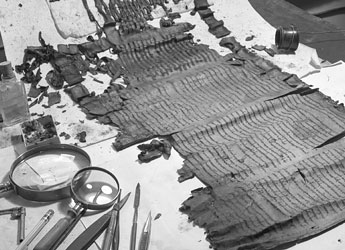Nature and Significance
The scrolls discovered in the vicinity of Qumran have all been ascribed to the Hellenistic-Roman Period, from the third century BCE to the first century CE. Various dating methods were employed, among them paleography (the study of ancient scripts) and radiocarbon (carbon-14) dating (a chemical test used for organic materials). Most of the scrolls are written on parchment (specially prepared animal skins, thicker if inscribed on the outer, "hairy" side, thinner if inscribed on the inner side). A smaller number are written on papyrus (a kind of paper made from the papyrus plant). The majority of the scrolls are poorly preserved: fewer than a dozen were found in a satisfactory state.
Hebrew is the most common language, though a small number of scrolls are written in Aramaic, and a few in Greek. The most common script is the Jewish script, also called the "Assyrian" or "square" script, which was widely used from the sixth century BCE on. However, about 14 biblical scrolls are written in the ancient Hebrew script, and many texts use a cryptographic script, combining mirror writing and a mixture of Jewish, ancient Hebrew, and Greek scripts.
These manuscripts constitute the oldest evidence for the text of the Hebrew Bible. Approximately two hundred copies of biblical books, most of them very fragmentary, were found at Qumran, encompassing almost all the books of the Hebrew Bible (with the exception of Nehemiah and Esther). Copies of non-canonical (apocryphal and pseudepigraphical) works were discovered as well; some of these had previously been known only in ancient translations (for example, Tobit, Jubilees, and 1 Enoch), while others were completely new to us (such as the Genesis Apocryphon or the Temple Scroll). The scrolls also include copies of original works, such as the Community Rule or the Habakkuk Commentary, composed by members of an isolated (sectarian) community.

Genesis Apocryphon

"Scriptorium" in Qumran